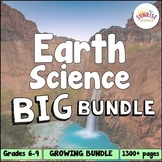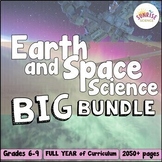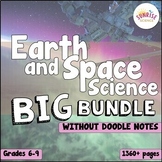Water Cycle Unit | Evaporation Condensation Precipitation Freshwater | Digital
- PDF
- Google Apps™
- Internet Activities

Also included in
- Looking for fun, student-centered, and engaging activities to add into your Earth Science curriculum? This is all of my resources for teaching Earth Science! This is a bundle of engaging resources including editable NGSS-aligned blended learning units, Cornell Doodle Notes, digital Pixel Art contentPrice $223.00Original Price $316.63Save $93.63
- This is a bundle of all of my resources for teaching Earth and Space Science at the middle school level! These resources include a mix of Cornell Doodle Notes, lab activities, inquiry activities, digital lessons and units, projects, and pixel art digital content review activities.✨ Please note thatPrice $327.00Original Price $450.24Save $123.24
- Looking for fun, student-centered, and engaging activities to teach about the water cycle, Earth's freshwater, and water scarcity on Earth?This Earth's Freshwater and the Water Cycle bundle contains engaging digital resources including a digital 3-week unit with a hands-on lab included, a unit test,Price $29.00Original Price $34.90Save $5.90
- This is a bundle of all of my resources for teaching Earth and Space Science at the middle school level, EXCLUDING the Cornell Doodle Notes. The resources in this bundle include a mix of digital lessons and units, lab activities, inquiry activities, projects, review activities, and assessments.✨ ThiPrice $259.00Original Price $369.00Save $110.00
Description
This 3-week Water Cycle Unit covers Earth's freshwater and the water cycle. It is a series of digital lessons plus a hands-on lab to help students to explore and make sense of the distribution of freshwater on Earth and how this water is recycled by the processes of evaporation, condensation, precipitation, cloud formation, transpiration, and infiltration. This unit also has a focus on water scarcity as students will calculate their own water footprints, learn about how satellites track freshwater availability, analyze water data maps, and consider what it would be like to live in a place that has water insecurity.
What is a blended learning unit? Blended learning combines online educational materials and opportunities with physical place-based classroom methods. This resource is the digital 'backbone' component of the unit that is editable and flexible for incorporating hands-on activities and labs and for varying the delivery of lessons to accommodate whole-class discussion, or small group, partner, or individual work.
But PLEASE NOTE! This is NOT a "webquest"! These lessons are written to be a sequential journey through the content and the teacher will still be facilitating the lessons. Students are not left to complete these lessons on their own. The teacher can use best practice pedagogy to have students interacting in whole-class discussions and small group work throughout the unit!
In this unit, students will:
- model the processes of evaporation and condensation at a particle level
- explain how satellites can collect data about the freshwater available at different places on Earth
- write a claim about the potential for water scarcity in specific places based on evidence from data
- explain the driving forces and processes by which Earth's water is continuously cycled through the atmosphere, on land, and in oceans
- design and build a water filtration system to purify dirty water
- model how freshwater is stored in aquifers and other reservoirs and naturally purified as part of the water cycle
- complete a graphic organizer to summarize a TED Talk about an aspect of water scarcity and present it to their peers
- video clips
- readings
- formative assessments
- post assessment
- ... and more!
These lessons are organized into 10 separate Google Docs that you will share with your students on Google Classroom. Each of these lessons takes 1 to 2 days to complete. Students will type directly on their copies of these Docs and these are what you will grade for each student.
My students have responded so well to this lesson format because they know what to expect. I love that I can schedule out all of the lessons in Google Classroom and I know what I’m teaching weeks out! You can modify the lessons as you need to. The prep is easy and the grading is so easy too.
This download includes a Unit Overview Google Doc that is for the Teacher. This document has all of the lessons written out in sections (Lesson 1, Lesson 2, Lesson 3, etc.) so that you can see everything in one place. This document notes how many days (45 minute periods) each individual lesson will usually take to complete and it contains most of the answers for the activities. This will help you with planning.
Please view the PREVIEW for more visuals of how this unit is organized.
These are the topics covered in each lesson:
Lesson 1: Water Footprint
Lesson 2: Freshwater Distribution on Earth
Lesson 3: Groundwater
Lesson 4: Evaporation
Lesson 5: Condensation and Clouds
Lesson 6: The Water Cycle 1
Lesson 7: Satellite Monitoring and Drought
Lesson 8: Infiltration
Lesson 9: The Water Cycle 2
Lesson 10: Freshwater Scarcity and Issues
This unit was designed to satisfy the following NGSS Standards: MS-ESS2-4: Develop a model to describe the cycling of water through Earth’s systems driven by energy from the sun and the force of gravity; MS-ESS3-1: Construct a scientific explanation based on evidence for how the uneven distributions of Earth’s mineral, energy, and groundwater resources are the result of past and current geoscience processes; and MS-ESS3-2: Analyze and interpret data on natural hazards to forecast future catastrophic events (in this case, drought) and inform the development of technologies to mitigate their effects.
This unit has been completed by my students and I'm confident that this unit will save you TONS of planning time! You will have 3 weeks of editable and flexible curriculum!
You can also take advantage of a HUGE discount off of this and all of the resources in the Earth & Space Science BIG Bundle!
You may also be interested in these resources:
The Water Cycle Cornell Doodle Notes
Earth's Water and the Water Cycle Abracadabra Pixel Art Digital Review
Plastics in the Oceans Distance Learning Lesson
Intro to Climate Change Distance Learning Lesson
Thanks for looking!
Sunrise Science









